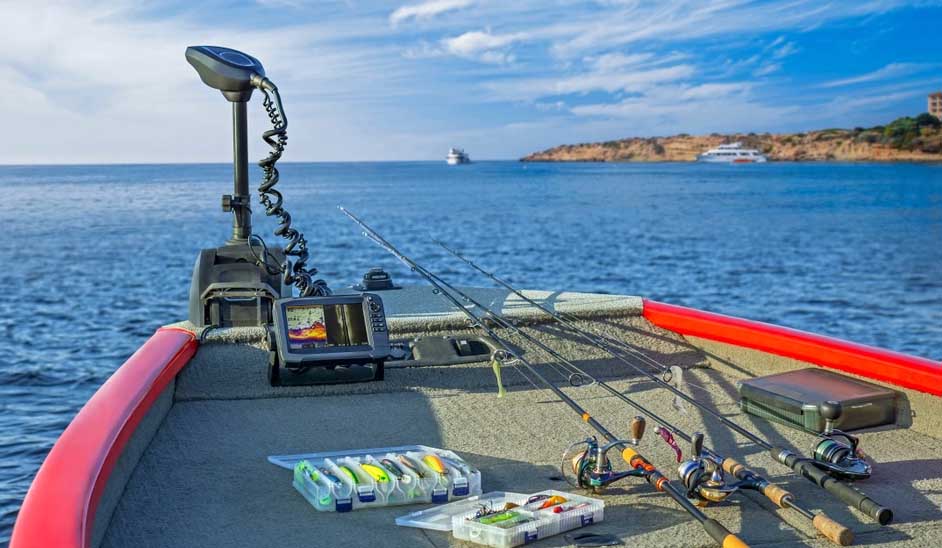How to Install a Fishfinder
Are you an experienced angler, small scale fisherman, or just a weekend hiker? Whoever you are, you’d probably do well when fishing if you had a fish finder onboard. You’d get a better catch, an easy time, and an awesome experience all together.
Nonetheless, the moment that you set foot in the sea, installing, or even replacing a fishfinder is definitely a challenge that’s coming your way sooner or later. So, the earlier you start to learn how to install a fishfinder, the better for you.
Lucky for you, when it gets to installing the binnacle-mounted units which use the transom-mounted transducers (which is the most common fishfinder), we have in-depth knowledge about it.
And even better, we are here to help you out. The whole process of installing such a fishfinder on the water is an easy DIY job which you can handle: – and we are going to show you how to.
Please take a look at our step by step guide to installing the binnacle-mounted fishfinder units with transom-mounted transducers.
Step 1: Installing the Binnacle Mount
To install the binnacle mount, what you need are some few tools, and you are good to go. Nonetheless, you’ll again have to find the very best location.
To do that, try to keep your fishfinder closer to the center of your helm. This will provide you with a top-notch viewing angle.
If you do this properly, the unit will sit between the waist height and the shoulder height levels. More importantly, when determining your location, make sure that you keep off areas that have overhead mounting locations.
This includes areas with electronics box and the other areas that make you have to crane your head back if you were using the unit.
Again, you must ensure that the location you are choosing for your binnacle mount allows you the freedom to quickly tilt and/or even turn your unit without necessarily hitting the main windshield, affixed items, the throttle, or compass.
Inspect your helm station too. Make sure you go from the back/ underside. This helps you to determine that there are no single obstructions on the underneath and that you’ve got enough or sufficient room to accommodate your bolts and wires.
Use the time again and ensure that you locate your power bus and the fuse block. Ensure their terminals are available (you can use specs that will enable you to have up to 3 or more terminals per stud).
With the perfect location found, you can use your binnacle template together with your fishfinder or just the binnacle itself like the template and mark the best location that you’ll put the mounting holes.
- Next, drill out your mounting holes using the power drill.
- Create the entry/exit for the wires on a clean console
- If there is a hole already, you can re-use it.
- Drill your hole right behind your binnacle mount – keep it large enough
- You can set the binnacle and fishfinder for a moment to ensure enough spacing between your mount and wire holes.
With your holes ready, use a silicone sealant and apply it around the binnacle mount’s base. Do the same around every hole before you run your bolts through.
Step 2: Run the Power Leads
Now, depending on the length that your supplied wires come with, you’d first want to lengthen or even shorten them first.
If you’ve got to lengthen them first, ensure that you do so using the right color-coding and the recommended gauges.
Make sure that you have focused on the right wire-to-wire connections, and this means using the crimped barrel connectors and proper protection with heat-shrink tubing (DO NOT SOLDER).
That done, you can now push your power leads through to the exit hole that you drilled. Keep going until the main plug gets enough freedom and comfortably sits on the unit without exposed wiring outside the helm.
Next, run these wires to the helm’s fuse block and then secure these wires after every 18 inches using tie-wraps. While doing the same, ensure that you eliminate the droops and slack.
If the fuse block comes with the male spade terminals, use the female spade connectors to crimp them up and again protect your connections using heat-shrink tubing.
For now, you can leave these terminal ends lying disconnected as you set out to complete the full installation.
Step 3: Mount the Transducer
Like I mentioned before, the same applies here. You must always find the perfect location before you start with the actual installation.
To do that, you can look for cool areas (usually a deeper area on the hull and one that has no strakes or any other items that could interrupt a smooth hull around it) and set the transducer there.
This is because anything that could disturb your water flow can easily create turbulence. When this happens, it will degrade the performance of the fishfinder.
With the best spot for the transducer found, now you can do this:
- Take the transducer’s bracket and hold it against the transom.
- Adjust its position until it gets a perfect hold on the face of your transducer.
- The bracket sits horizontally and at about 1/8-inch below your hull’s running surface.
- Use a pencil to mark the perfect location for the bracket’s mounting
- Do not mount your transducer yet
- Instead, run your transducer’s wire through to the dash
NOTE: If the boat has an old fish finder that uses a transom mount transducer and does not run the new wires. Simply cut the transducer off its end and then use your old wires to set up the new one through your wiring chase.
- Next, pull the wires to the helm
- Now route them up through the holes that you’ve made
- Do this while coiling other extra wires that you’d have in your helm
- Secure any extras with the tie-wraps or even cushioned clamps
Now, using the first markings you made on the transom, you should drill the pilot holes and use them to mount the brackets of your mounting screws. Use a power drill to do that before using the adhesive/sealant to coat your mounting screws.
With that done, you can then screw your mounts. Keep doing this while holding your brackets in place. One more thing that you must do is to use lots of adhesive/sealant. This is because water getting through the transom holes will spell disaster.
NOTE: Never cut the kayak’s transducer’s wire to size. If you do, any new connection that you’ll make around the plug will create extra resistance around the wires. As such, your fishfinder’s performance eventually suffers.
Again, don’t bundle the kayak’s transducer’s wire together with your engine’s wiring harness/ the VHF cable since they can again cause some electrical type of interference.
Step 4: Finish Up the Job
Finally, when it comes to how to install a fish finder, it is time to wrap up your work. At this point, you should take some time and protect the main wires inside the helm. Seal these wires off your wiring hole that sits behind the binnacle mounts.
Next, take a grommet, then use it to seal, give this area a complete seal. The use of a silicone sealant is also good if you don’t have a grommet.
Once this is done, you should again cover that area with a clamshell vent. This is done by marking the clamshell fixing points in place and then drilling the holding holes over that same area.
Now you have set up the best route to complete the final wiring and connection for your fishfinder, and here is how that is done.
- Make sure the battery is switched
- Connect the power leads
- Next, plug the power and transducer’s wires into the fishfinder
- Allow the seal used on transducer’s mountings and holes to dry
- Do not rush the drying process – some take up to seven days
- When the process is done, you can take your boat for a test run
Conclusion
I guess you’ve seen the best process of how to install a fishfinder. Now that you are set, you can take your boat for a test drive. From the onset, if the boat is turned on, if you did proper wiring, the fishfinder should work.
A fish finder is very important. It saves you time and allows you to get the best fishing experience. More importantly, the fish finder is ideal for easy monitoring of the right areas for fish and the main areas that you should keep off.
Such an experience is really important for new anglers that want less frustrating fishing experiences. For new anglers, this is a must-have model gadget.
Remember that you should be very patient to allow all the sealant that you applied to dry up. This is important since when it comes to the boating vessels, there is always the need to have 100 percent confirmation that there won’t be any water intrusion.

